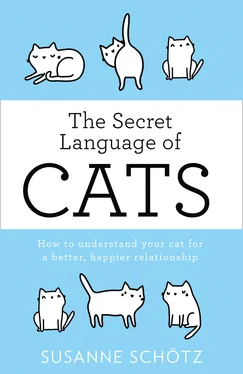3. Sounds that are produced with an open tense mouth are often associated with offensive or defensive aggression, but also with sounds directed at prey
a. The Growl(Snarl): A guttural, harsh, very low- pitched, regularly pulse-modulated sound of usually long length (duration) produced with the mouth slightly open during a slow, steady exhalation. A growl often sounds like a very deep and trilling r : [ɡʀː], [ʀː], or a creaky [ɹ̰ ː] or [ʌ̰ ː]. Growling is used to signal danger or to warn or scare off an enemy, and is often combined, with howling and hissing.
b. The Hiss and The Spit(the more intense variant): A voiceless fricative (noisy) sound often produced with an open mouth with a raised upper lip, visible teeth and an arched tongue, with a hard exhalation. A hiss is often a warning and deterrent sound, but may also be an involuntary reaction to when a cat is surprised by an (apparent) enemy. The cat changes position with a startle and breath is forced rapidly through the slightly open mouth before stopping suddenly: [fːhː], [çː], [ʃː] or [ʂː]. Spitting is more explosive, sometimes with a k - or t -like sound at the beginning of the sound: i.e. [͡ʈʂː], [k͡ h͜͜͜ ː] or [k͡ ʃː], and sometimes a little saliva is even expectorated.
c. The Snarl(Scream, Cry, Pain Shriek): A very loud, harsh and often high-pitched sound produced just before or during active fighting, often with [a], [æ], [au] or [ɛʊ] vowel qualities. A snarl is sometimes used as a final warning, but injured or sick cats may cry when they are in pain.
d. The Chirp and The Chatter(Prey-Directed Sounds): Sounds that are sometimes produced around prey (birds, rodents, insects). A hunting instinct where the cat attempts to imitate the calls of the prey or the killing bite, for example when a bird or an insect catches the attention of the cat. There seem to be several subcategories based on their phonetic characteristics.
i. The Chatter(Cackle, Teeth Chattering): A voiceless, very rapid, stuttering or clicking sequence of sounds produced with the jaws juddering, which produce a crackling k -consonant: [k̟ =k̟ =k̟ =k̟ =k̟ =k̟ =] or [k k k k k k].
ii. The Chirp: A voiced, short call, said to be mimicking the chirp of a bird or rodent. The pitch is often monotone or falls toward the end: [ʔə]. It is generally repeated in sequences [ʔɛʔɛʔɛ]. Softer, weaker variants have also been observed like soft tweetswithout any clear initial [ʔ] and with varying vowel quality, for example [wi] or [ɦɛu]. There are also variations where a soft chirp or tweet is prolonged, so that it almost sounds like a tweedle or warble, and with rapid changes in the pitch or melody. These variations are often combined with tremor or quavering: for example [ʔəɛəɥə].
Now, having already read my descriptions of the most important cat sounds, there is no point in reading any farther, or is there? Well, in the chapters ahead I would like to explain a little bit more about the most important cat sounds and above all else, I would like to discuss some of the situations or contexts where they typically occur.
Конец ознакомительного фрагмента.
Текст предоставлен ООО «ЛитРес».
Прочитайте эту книгу целиком, купив полную легальную версию на ЛитРес.
Безопасно оплатить книгу можно банковской картой Visa, MasterCard, Maestro, со счета мобильного телефона, с платежного терминала, в салоне МТС или Связной, через PayPal, WebMoney, Яндекс.Деньги, QIWI Кошелек, бонусными картами или другим удобным Вам способом.












